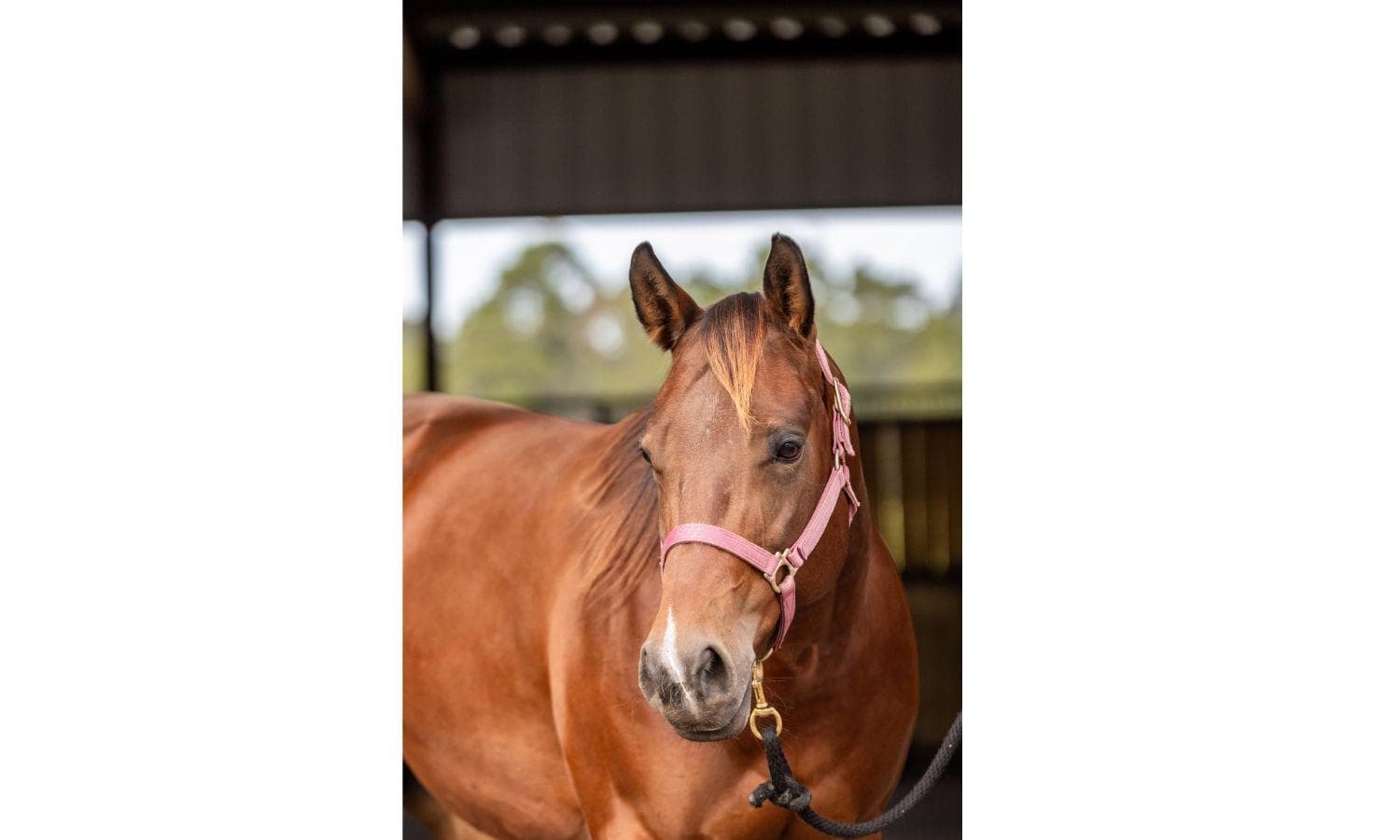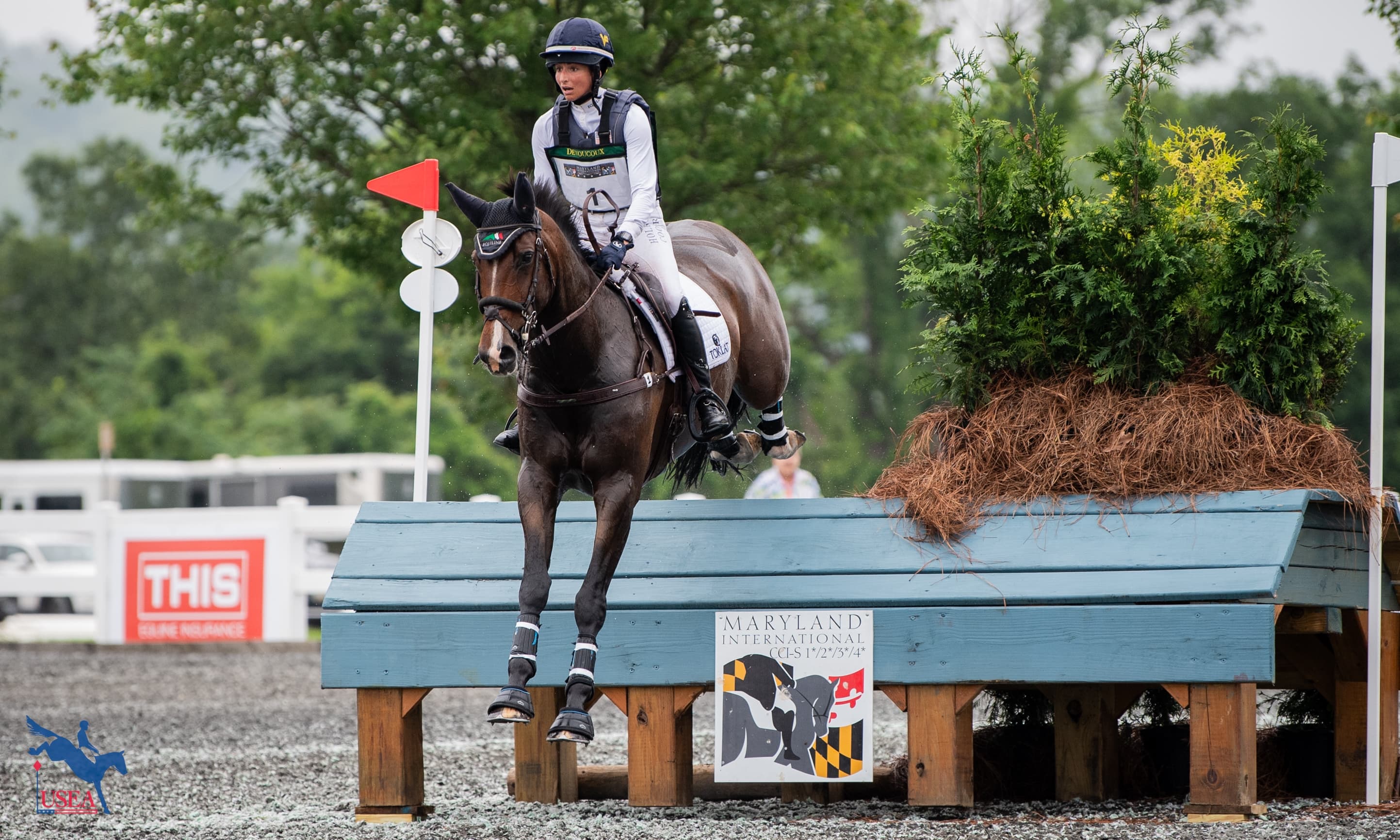The Invisible Injury, Shining Light on Concussions
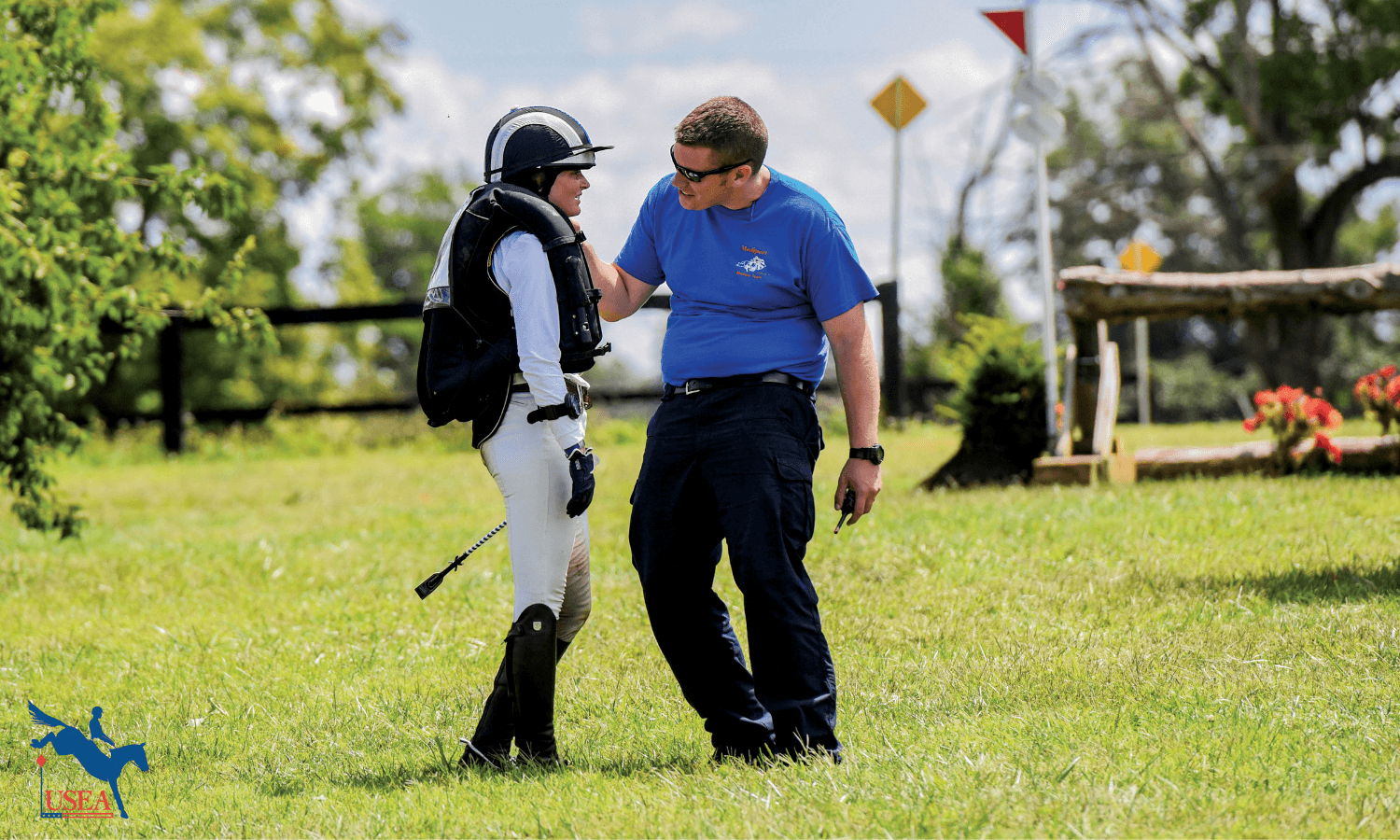
This article originally appeared in the 2021 Issue 2 of Eventing USA magazine.
“I had no idea that I had a concussion until I got sick at night and woke up with a bad headache that wouldn’t go away,” said eventer Mia Farley who fell at an event a few years ago and ended up with a bad concussion.
This story isn’t uncommon – concussion symptoms may not show up for hours or days after the impact. “Riders think ‘I have to be knocked out to get a concussion,’ or ‘I have to land on my head.’ Which is not true. You can land hard on your feet and it can still shake up the brain. It has nothing to do with losing consciousness. People also need to realize that the majority of concussions don’t happen in competition – they happen at home,” said Dr. Mark Hart, the U.S. Equestrian Team Physician and FEI Medical Committee Chair.
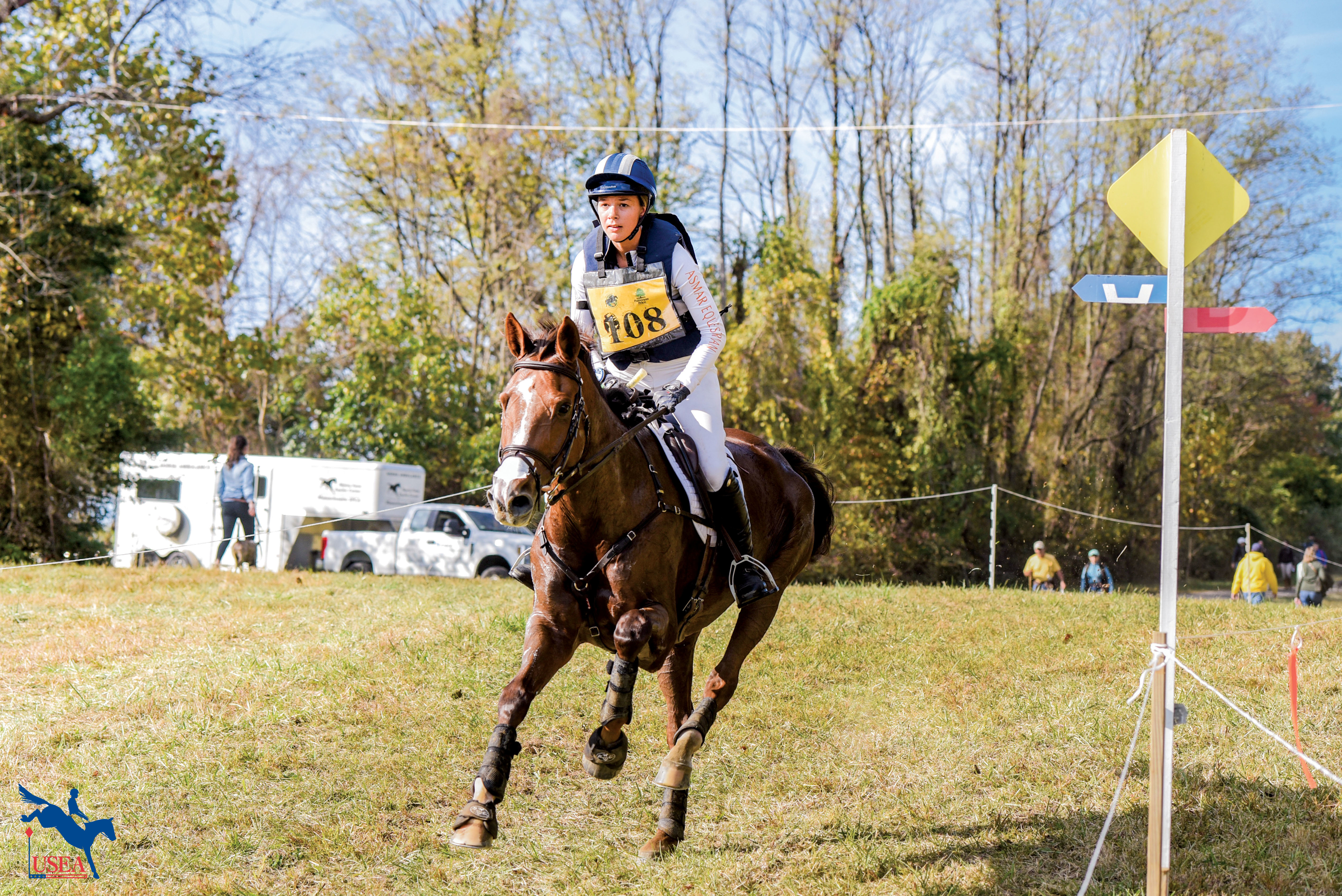
According to the Centers for Disease Control and Prevention (CDC), 1.6 to 3.8 million concussions occur in sports and recreational activities each year. Because all head injuries are potentially serious, it is important to recognize and properly treat them early. A 2016 study in the Journal of Neurosurgery found that equestrian-related sports accounted for 45.2 percent of sports-related traumatic brain injuries (TBI). And Dr. Hart said that reporting concussions is one of the biggest challenges – competitions are getting better at reporting, but people aren’t self-reporting at-home injuries.
What is a Concussion?

The CDC says a concussion is a type of TBI caused by a bump, blow, or jolt to the head or by a hit to the body that causes the head and brain to move rapidly back and forth. This sudden movement can cause the brain to bounce around or twist in the skull, creating chemical changes in the brain and sometimes stretching and damaging brain cells.
Medical providers may describe a concussion as a “mild” brain injury because concussions are usually not life-threatening. Even so, the effects of a concussion can be serious.
I've Been Diagnosed with a Concussion, Now What?
Dr. Cindy Lin, an equestrian and Clinical Associate Professor of Sports & SpineMedicine, University of Washington, Seattle, Wash. and Associate Director of Clinical Innovation, The Sports Institute, said that it is a common misconception that concussions are minor injuries that don’t require time off. “Returning to riding, school, or work while you’re still having concussion symptoms, might make symptoms worse or last longer,” said Dr. Lin. “That’s why a period of “brain rest” from mentally or physically taxing activities is an important part of concussion recovery.”
“Concussions are challenging because it’s an invisible injury meaning your friends, family, and riding coach can’t see that you’re injured and need time off to recover in the way that a more visible injury such as a bone fracture in a cast would,” continued Dr. Lin. “Riders who are suspected to have a head injury should stop riding and have a medical evaluation before they are cleared to return to their sport.”
Farley agreed with Dr. Lin’s assessment of the invisible injury. She said that staying off screens was the hardest part of her recovery, but staying in a darker room and at least trying to nap was the most helpful in curing her headaches, nausea, light sensitivity, and feeling lethargic all the time.
Farley’s recommendation for other concussion-sufferers? “Take your time and take it seriously. Give yourself a good two weeks of rest and once you start feeling better give it another week. The brain is one of the hardest things to heal because it’s not physically visible, so you have to make your health your priority.”
Dr. Lin explained that most concussion symptoms resolve within a few weeks, although for some individuals, the symptoms can last longer in what is called post-concussion syndrome. “It’s important to seek medical attention when you suspect that you might have had a head injury,” she said. “The signs and symptoms of a concussion can vary greatly with the most common symptoms being headache, dizziness, difficulty concentrating, or feeling in a fog.”
“After that initial period of brain and physical rest, once symptoms completely resolve and your doctor has cleared you, slowly resuming exercise plays an important role in active recovery. That might mean that after your concussion symptoms have fully resolved, the first day you get back in the saddle, you should be doing only a light, short workout i.e. walk and trot. Stop if you feel any symptoms. Once you are riding without any symptoms, you can start building in, for example, direction changes and gait transitions before progressing to the next stepwise level of activity. Your healthcare provider or a sports medicine physician can help provide guidance for a safe return to riding.”
Dr. Hart said, “the better you take care of yourself early after a concussion, the quicker you can safely return to training and competition.” However, he cautioned the importance of doing your best to prevent a second concussion, especially in a short time frame after a previous injury. With concussions the math isn’t as simple as 1 + 1 = 2, but it is more like 1 + 1 = 10. Dr. Hart also added that riders should still follow the USEF’s return to play protocol even if they weren’t injured in a competition.
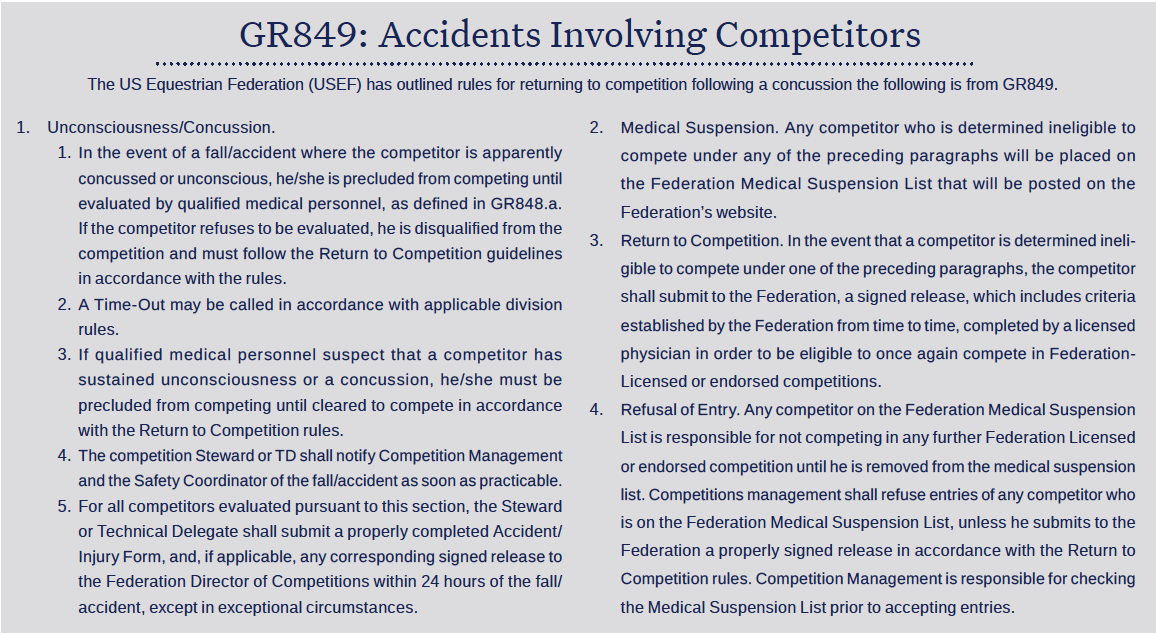
What Can I Do to Prevent a Concussion?
“Due to the unpredictable nature of horses, their height, and high speeds involved, equestrian sports present a high risk for head injuries,” said Dr. Lin. “Efforts are being made to understand injury patterns in competition and to prevent horses from going down on course as that can lead to catastrophic rider injuries as seen in rotational falls and horse racing injuries. Accidents can be multifactorial, and it is important to consider horse and rider factors, the environment or weather, as well as what can be changed from a course and obstacle design perspective to reduce risks.
Dr. Lin continued by explaining improving equestrian safety around injuries will need to address safety education, helmet policies in competitions, state laws requiring youth are helmeted when riding, and changing sports culture to make wearing helmets more widely accepted.
Dr. Hart also noted the importance of wearing helmets when not mounted, but around horses. “A lot of injuries and concussions happen on the ground as well – you can get knocked down, kicked, or squished between the barn door,” he explained. “I think people are increasingly aware of the importance of always wearing helmets when they are on a horse, but I would strongly encourage that if you are around a horse, you should pretty much have a helmet on to reduce potential injuries.”
While wearing a helmet will certainly help with head injuries, Dr. Lin did say that a common misconception regarding helmets is that they prevent all concussions, which they don’t. “Wearing a helmet can reduce the risk of skull fractures. Newer helmets with multidirectional impact protection systems (MIPS) technology can reduce the risk of some concussions. Much more work needs to be done to raise the bar on helmet innovations to improve their effectiveness in reducing concussion risk.”
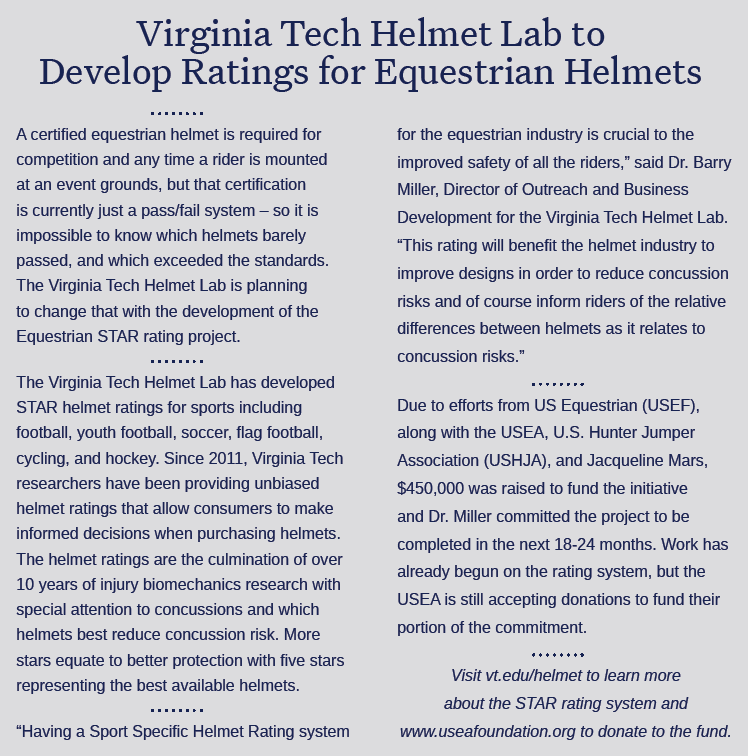
Concussion awareness has become a hot topic in recent years with more and more sports taking concussions seriously and putting steps in place for proper protocols to limit athletes’ risk of continuous concussion. Being educated on concussion prevention, signs and symptoms, and response is imperative to helping eventers suffer from the long-term effects of concussions. Learn more at usef.org, cdc.gov, and thesportsinstitute.com/ concussion-basics/.
Did you enjoy this article? Want to receive Eventing USA straight to your mailbox? Members receive Eventing USA as part of their USEA Membership or you can purchase individual issues from the USEA Shop.

